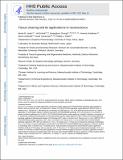Tissue clearing and its applications in neuroscience
Author(s)
Ueda, Hiroki R; Ertürk, Ali; Chung, Kwanghun; Gradinaru, Viviana; Chédotal, Alain; Tomancak, Pavel; Keller, Philipp J; ... Show more Show less
DownloadAccepted version (1.185Mb)
Open Access Policy
Open Access Policy
Creative Commons Attribution-Noncommercial-Share Alike
Terms of use
Metadata
Show full item recordAbstract
© 2020, Springer Nature Limited. State-of-the-art tissue-clearing methods provide subcellular-level optical access to intact tissues from individual organs and even to some entire mammals. When combined with light-sheet microscopy and automated approaches to image analysis, existing tissue-clearing methods can speed up and may reduce the cost of conventional histology by several orders of magnitude. In addition, tissue-clearing chemistry allows whole-organ antibody labelling, which can be applied even to thick human tissues. By combining the most powerful labelling, clearing, imaging and data-analysis tools, scientists are extracting structural and functional cellular and subcellular information on complex mammalian bodies and large human specimens at an accelerated pace. The rapid generation of terabyte-scale imaging data furthermore creates a high demand for efficient computational approaches that tackle challenges in large-scale data analysis and management. In this Review, we discuss how tissue-clearing methods could provide an unbiased, system-level view of mammalian bodies and human specimens and discuss future opportunities for the use of these methods in human neuroscience.
Date issued
2020Department
Massachusetts Institute of Technology. Institute for Medical Engineering & Science; Picower Institute for Learning and Memory; Massachusetts Institute of Technology. Department of Chemical Engineering; Massachusetts Institute of Technology. Department of Brain and Cognitive SciencesJournal
Nature Reviews Neuroscience
Publisher
Springer Science and Business Media LLC